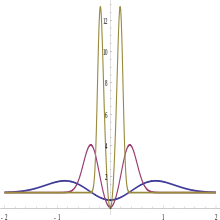Hodges' estimator
In statistics, Hodges’ estimator[1] (or the Hodges–Le Cam estimator[2]), named for Joseph Hodges, is a famous counterexample of an estimator which is "superefficient",[3] i.e. it attains smaller asymptotic variance than regular efficient estimators. The existence of such a counterexample is the reason for the introduction of the notion of regular estimators.
Hodges’ estimator improves upon a regular estimator at a single point. In general, any superefficient estimator may surpass a regular estimator at most on a set of Lebesgue measure zero.[4]
Construction
Suppose is a "common" estimator for some parameter θ: it is consistent, and converges to some asymptotic distribution Lθ (usually this is a normal distribution with mean zero and variance which may depend on θ) at the √n-rate:
Then the Hodges’ estimator is defined as [5]
This estimator is equal to everywhere except on the small interval [−n−1/4, n−1/4], where it is equal to zero. It is not difficult to see that this estimator is consistent for θ, and its asymptotic distribution is [6]
for any α ∈ R. Thus this estimator has the same asymptotic distribution as for all θ ≠ 0, whereas for θ = 0 the rate of convergence becomes arbitrarily fast. This estimator is superefficient, as it surpasses the asymptotic behavior of the efficient estimator at least at one point θ = 0. In general, superefficiency may only be attained on a subset of Lebesgue measure zero of the parameter space Θ.
Example

Suppose x1, …, xn is an Independent and Identically Distributed (IID) random sample from normal distribution N(θ, 1) with unknown mean but known variance. Then the common estimator for the population mean θ is the arithmetic mean of all observations: . The corresponding Hodges’ estimator will be , where 1{…} denotes the indicator function.
The mean square error (scaled by n) associated with the regular estimator x is constant and equal to 1 for all θ’s. At the same time the mean square error of the Hodges’ estimator behaves erratically in the vicinity of zero, and even becomes unbounded as n → ∞. This demonstrates that the Hodges’ estimator is not regular, and its asymptotic properties are not adequately described by limits of the form (θ fixed, n → ∞).
See also
Notes
- Vaart (1998, p. 109)
- Kale (1985)
- Bickel (1998, p. 21)
- Vaart (1998, p. 116)
- Stoica & Ottersten (1996, p. 135)
- Vaart (1998, p. 109)
- Vaart (1998, p. 110)
References
- Bickel, Peter J.; Klaassen, Chris A.J.; Ritov, Ya’acov; Wellner, Jon A. (1998). Efficient and adaptive estimation for semiparametric models. Springer: New York. ISBN 0-387-98473-9.
- Kale, B.K. (1985). "A note on the super efficient estimator". Journal of Statistical Planning and Inference. 12: 259–263. doi:10.1016/0378-3758(85)90074-6.CS1 maint: ref=harv (link)
- Stoica, P.; Ottersten, B. (1996). "The evil of superefficiency". Signal Processing. 55: 133–136. doi:10.1016/S0165-1684(96)00159-4.CS1 maint: ref=harv (link)
- Vaart, A. W. van der (1998). Asymptotic statistics. Cambridge University Press. ISBN 978-0-521-78450-4.CS1 maint: ref=harv (link)